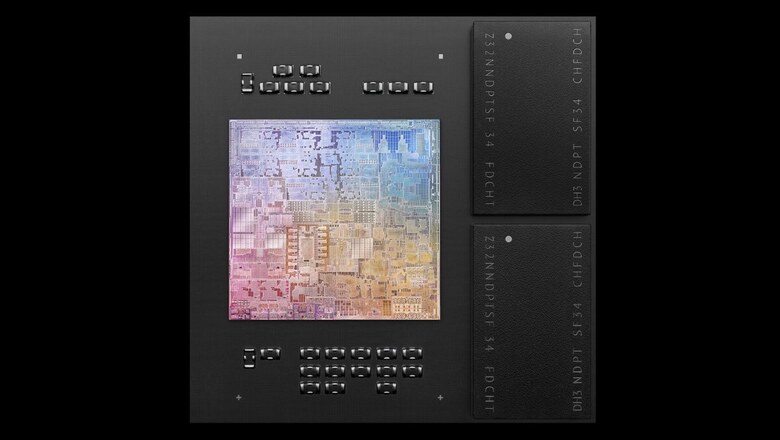
views
It has barely been a few weeks since Apple released the new variants of the MacBook Air, MacBook Pro 13 and the Mac Mini with the very powerful M1 chip marking the switch from Intel chips to the new Apple processors and has already taken a significant performance lead over rival Intel chips. But if you thought Apple would rest on its laurels, you would be completely off the mark. The next additions to the processor line, the Apple M series, are taking shape. One of them is expected to be a 32-core chip and will have the most powerful processors in the Intel Core series, the Core i7 and the Core i9 variants, in its sights. By the time next year wraps up, we could be seeing this new processor as part of the expected refresh cycles for the MacBook Pro 16, the iMac line-up as well as the Mac Pro.
The roadmap of Apple’s chip releases and the subsequent Mac refresh cycles indicate the company is confident of making the transition away from Intel chips for its computing devices, quite smoothly. Bloomberg reports that the next two lines of Apple chips are also planned to be more ambitious than some industry watchers expected for next year. Apple had, earlier this year, confirmed their plans for a two-year period to switch all Mac computing devices from Intel chips to their own Apple M series chips. The speed at which the transition is progressing, we may very well see this mission accomplished by the end of the year 2021, instead of sometime in 2022.
The current M1 chip, available in 8 core CPU and 8 core GPU as well as 8 core CPU and 8 core GPU variants, is already delivering better performance than similar spec Intel chips, including the Core i5 variants. With the expected 32-core chip, expected to be called M1X, Apple will further reset the performance benchmark and this chip could be used to further differentiate the higher spec variants and options in the Mac computing device line-up.
Intel’s revenue share from Mac computing devices is less than 10 percent, but it could get further impacted by the extreme performance improvements that the Apple M series chips are demonstrating, and that could cause some discontent in the Windows computing device space. Intel will have to seriously up the performance gains game with the upcoming iterations of the Core series of processors, and there is nothing to suggest that Intel cannot deliver when the going is tough. But it sure will be more difficult than expected.
It is quite possible that Apple will keep the 7 cores and 8 cores variants of the M1 chip alongside the Apple M1X and any other variants launched, with these being positioned for different machines and specifications. If you are well versed with the Intel processor line-up, Apple’s version of the Core i5 and the Core i7 and indeed the Core i9 families, positioned at different price points for different usage scenarios and form factors. These processors could be used in the upcoming Apple MacBook Pro 16, for instance. Then there is the Apple iMac line as well as the Mac Pro which await the switch from Intel processors to Apple’s own chips—something that should most certainly happen next year.
Speaking of which, the Apple MacBook Pro 16 refresh for next year is hugely awaited. The flagship MacBook should ideally usher in the newer processor and the performance boost it brings. It may be possible that Apple could use this chip as the big differentiator between the MacBook Pro 16 and the MacBook Pro 13, if it wants to make that distinction that is. There is expectation, largely revolving around analyst Ming Chi Kuo’s claims, that there could be a 14-inch Apple MacBook Pro on the way. Will that replace the MacBook Pro 13, we do not know. Theoretically, it may be a like-for-like replacement the way the MacBook Pro 16 was for the MacBook Pro 15. Will that get the Apple M1 or the expected Apple M1X chips, hard to say.
Then there are the Apple iMacs. Refreshed in the second half of 2020, the iMac 21.5-inch and the iMac 27 should most likely make the switch away from Intel’s chips with the next update. It may also be time for a design refresh. While it has become slimmer and there have been refinements along the way, the larger design of the iMacs has remained the same since the refresh in 2012.
Apple could also look at both processor variants for the same families of Macs as well. For instance, we could have the lower spec and more affordable of the MacBook Pro 13 run the 8 core Apple M1 which the more powerful configurations could get the 12-core iteration of the Apple M1X—either by default or as an optional configure your Mac upgrade.
Apple has maintained that there are more Intel powered Mac computing devices to come. It is hard to see how, and where they would fit amidst the significantly superior performance that the next Apple M series chips are set to offer and the M1 currently does, both in terms of outright speed and battery life. It was always supposed to be a two-year switch cycle, starting a few weeks ago when the new M1 powered MacBook Air, new MacBook Pro 13 and the new Mac Mini were released. We may see the end of Intel’s run with the Apple Macs by the time the year 2021 closes.
Read all the Latest News, Breaking News and Coronavirus News here




















Comments
0 comment